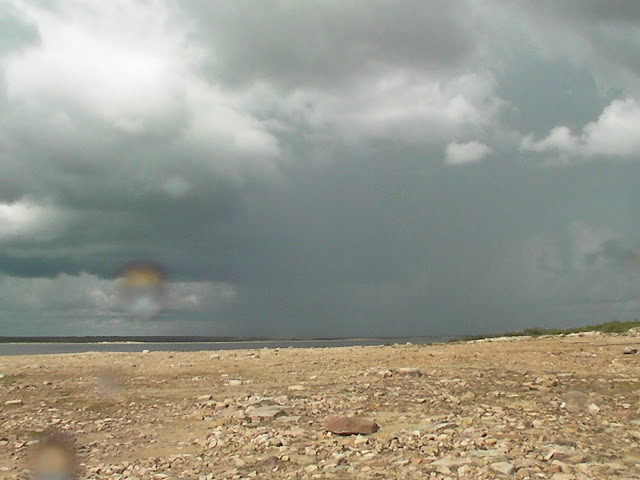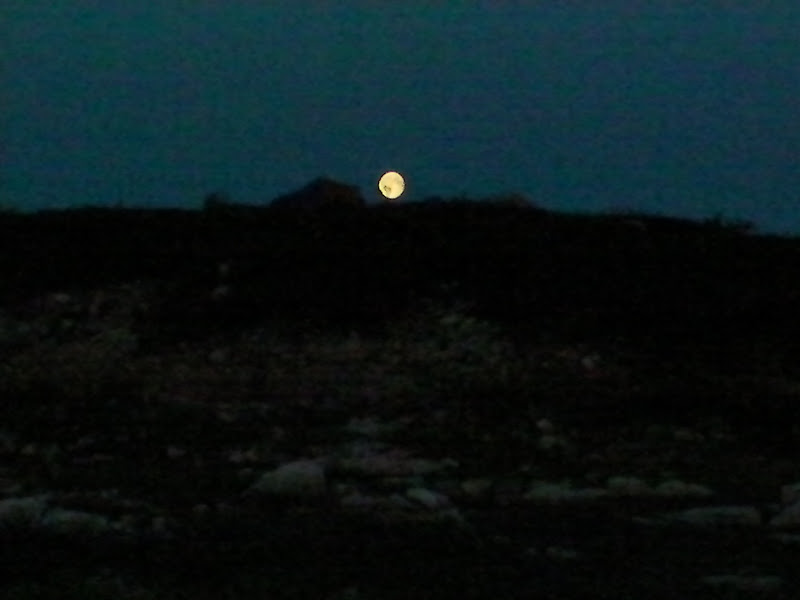
July 22- July 25
After our first full day on the Thelon River we had completed 187 kilometres, with 185 left to do. We were half way to our destination at Warden's Grove with 8 days left to our scheduled date of pick up. We had taken 10 days to get here, and we had to work very hard to make the progress we did. We were all concerned that if we encountered more difficult terrain, or if we ran into bad weather we would not make our destination in time.
Our fears were allayed to a large extent by the fact that over the next few days we made very good progress and the weather remained quite fair. In fact, over the next few days we travelled 133 kms., averaging 44 kms. per day. We managed to catch fish and had a feast of pike or trout each night.
The topography of the river in this section is dominated by sand eskers and sandstone canyons. The river current was very fast, at times the canoe reached speeds of 10-12 km/hr with little or no paddling. The swifts and sandstone ledges became more evident as we approached the delta where the river enters Eyeberry Lake.
Through one of the sections of swifts, w
 here the river entered a shallow canyon, Nestor and Roman were in the lead canoe. Taras and I were about 200 metres behind and I noticed that the horizon fell away in a sharp line. I told Taras to head over to the left shore and instinctively began to draw the canoe in that direction from the bow. It was then that we saw that Nestor and Roman were in trouble as they hit the ledge and began to scramble out of the listing canoe. The two were able to avert disaster by holding onto the canoe and climbing onto a large exposed sandstone boulder in the middle of the river. In the process they broke a paddle and lost another one to the current.
here the river entered a shallow canyon, Nestor and Roman were in the lead canoe. Taras and I were about 200 metres behind and I noticed that the horizon fell away in a sharp line. I told Taras to head over to the left shore and instinctively began to draw the canoe in that direction from the bow. It was then that we saw that Nestor and Roman were in trouble as they hit the ledge and began to scramble out of the listing canoe. The two were able to avert disaster by holding onto the canoe and climbing onto a large exposed sandstone boulder in the middle of the river. In the process they broke a paddle and lost another one to the current.Meanwhile, Taras and I slipped down a set of rapids on the river left. The rapids were tricky but manageable once Taras and I had our communication perfected. I kept yelling, "Draw Left!" Taras and I spotted the lost paddle and were able to retrieve it from the eddy. We talked about watching for signs in the river for differences in elevation that could spell trouble. This was to me a further reminder how little fast water experience my travelling partners had.
Eyeberry Lake and beyond
We entered Eyeberry Lake on the western shore at the north end of the large island in the delta. The cross winds were moderate and made for a difficult paddle, but we managed to reach the end of the lake in two hours. After the lake the river picked up speed as we paddled through canyons of sandstone and shale. We negotiated a set of class II rapids and about 5km of swifts and a little later a set of class II rapids where the river was split by two islands. The left channel was runnable.
At some point in the remaining few days, there was a suggestion that since we were making good time, we might be able to arrange an earlier flight out. The others had young families, so perhaps there was a felt need to cut the trip short by a couple of days. In retrospect, this plan was unreasonable since our flight out was coordinated with an incoming flight carrying another of Tundra Tom's clients. The extra flight would have meant an extra cost for Tom.
The result was that there now seemed to be added pressure to push on. The good travel days we had up to this point on the Thelon added to the anticipation of completing earlier than planned. The weather on July 26, however, slowed our progress tremendously. The north wind was cold and rain threatened throughout the day. Added to this delay, Nestor left his fishing rod on shore at the campsite and only discovered it missing after we had been on the water an hour. This meant a two hour delay while Taras and Roman offered to return to the campsite to retrieve it. Later in the day we were further halted by a storm and a quickening wind. The day eventually cleared but the wind remained strong. We were only able to make 20 km. this day.
The Thelon Canyon
During the final section of the river, toward Warden's Grove, the river picks up speed as it cuts through sandstone canyons. Heeding Tundra Tom's advice we approached a class II set of rapids with a tight left past the bulk of the turbulent water and rocks. A few kilometres down stream from these rapids we approached the Thelon Canyon, a 7 km stretch of ledges and chutes that needed to be portaged and tracked. We chose to portage from the left bank, which I later learned from Rob Kesselring was a mistake. The decision would add misery to our trek that could have been avoided had we chosen the slightly longer, but more even terrain of the right bank.
We estimated our portage to be about 3 km each pass. Given that we had three loads of gear, it
 would mean that we would have to make three loaded and two unloaded trips, a total of 15 km. At best this would take us six or seven hours. Since we had arrived at 1:30 in the afternoon, I suggested that we take the canoes over in the afternoon, camp overnight at the head of the canyon and trek the last of the gear over in the morning after a good night's sleep. To my surprise and dismay the other three were determined to complete the portage and to continue paddling late into the evening.
would mean that we would have to make three loaded and two unloaded trips, a total of 15 km. At best this would take us six or seven hours. Since we had arrived at 1:30 in the afternoon, I suggested that we take the canoes over in the afternoon, camp overnight at the head of the canyon and trek the last of the gear over in the morning after a good night's sleep. To my surprise and dismay the other three were determined to complete the portage and to continue paddling late into the evening.Whenever I have travelled with others, there is always an ethic that says that we do not push the trip beyond what any of the members feels they are able to do. I felt at that time, I would be unable to find reserves to complete 7 hours of physical endurance, let alone paddle after the portage. The desire to push on and complete the trip early, however, meant that the three friends were not going to consider my plan to take our time and conserve our energy. No one seemed willing to challenge Nestor's desire to push on.
The portage itself was gruelling. On the second trip over carrying the canoe with Taras, I fell several times as my feet sank into the bog of the tundra. I responded in frustration. The trail
 was uneven and meandered through bog, up and down sand and stone ridges and through dense bush. We were plagued by black flies, but that was the least of my suffering. By now I had developed a deep and abiding resentment toward my travelling partners, who up to this point had been ideal travelling companions.
was uneven and meandered through bog, up and down sand and stone ridges and through dense bush. We were plagued by black flies, but that was the least of my suffering. By now I had developed a deep and abiding resentment toward my travelling partners, who up to this point had been ideal travelling companions.Reaching a sandy beach on the right bank we made the decision to make camp. This was in part because we could not see the next set of rapids in the setting sun (the time must have been 10 or 11 at this point). After a quick dinner we took some photos of the full moon above the tents and then retired for the night.

Warden's Grove
With only about 10km left to our destination we learned that we would not be leaving two days early, but rather on our scheduled flight on July 30th. The next morning we ran the last set of rapids and spent some time where the rapids undercut the cliffs on the right bank. There was an eddy here where we went bathing and watching cliff swallows that had built their nests of clay in the sandstone overhang.

We now had a couple of days to spend at Warden's Grove, but unfortunately neither Taras, nor Nestor recognized the spot from their last trip. The place I had marked on my GPS was a place that reminded them of the campsite, but they remained unconvinced and after phoning the air service, we pushed on down the river about 1 km past the coordinates they gave us.
Over the next afternoon Roman and I tried unsuccessfully to locate the Warden's Grove cabin (it must have been about 700 metres up river from where we ended up searching). It was a disappointment to me not to locate the cabin knowing that I may never have another chance to visit this river. I had read Chris Norment's account of his experiences researching the Harris sparrow from the cabin in his book "Return to Warden's Grove" and had hoped to recognize the places he had described so intimately.
My disappointment was allayed to a large extent when Roman and I were alerted by Taras and Nestor over the walkie-talkie that a bull muskox was on the left shore of the river at the point I now believe must have been Warden's Grove. We paddled up river to within 50 metres of this majestic animal feasting on the shore grasses. He was seemingly unconcerned with our presence as we took videos and pictures from the canoes. This was a highlight of the trip.
The last day on the river was spent fishing, relaxing and sorting out gear for the flight home. The memories of this trip would be mixed. There was adventure for sure and the splendour of the tundra was unforgettable. The physical nature of the trip was satisfying in that I came away with a sense that I could still tackle a trip of this nature. I regret that I was not able to feel a closer bond with those I travelled with. None of us expressed a wish to travel again together.



No comments:
Post a Comment